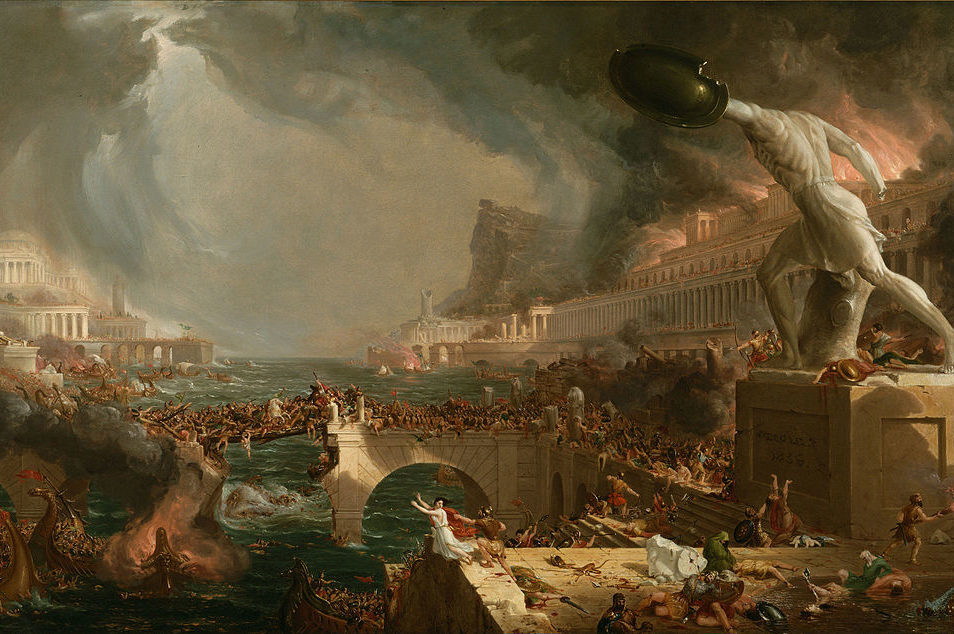Are we in our own revolutionary moment? Many of our leading institutions clearly believe so. Yale University has been working overtime to prove it is on the right side of history. ‘Problematic’ colleges have been renamed. ‘Offensive’ stained-glass windows have been knocked out. Only the leadership of an Ivy League school could spread such a poisonous rash. Heading the charge against the Dead White Male has been a progressive Yale bureaucracy that is, for the most part, pale and stale.
Now the task of dismantling Yale’s famous art history survey course has fallen to a scholar I respect, Tim Barringer. British-born, Barringer is the Paul Mellon Professor of the History of Art at Yale University and has been a leading curator at the Metropolitan Museum. He even mounted the Met’s exceptional 2018 exhibition on Thomas Cole.
Following a 2017 mandate to ‘decolonize’ Yale’s Department of English, Barringer is giving over the keys of Yale’s famous art survey course to the identity vandals. According to the Yale Daily News, instead of one class that will tell the story of art from ‘Renaissance to the Present’, new courses will, Barringer says, be devised to consider art in relation to a five-step history lesson, ‘questions of gender, class and race’, with further discussion of art’s ‘involvement with Western capitalism’. Of course, ‘climate change’ will also be a ‘key theme’.
Art doesn’t fare well in revolutionary times. Likewise, revolutionary sentiments are often revealed in the treatment of art. If only Professor Barringer had looked more carefully at another five-step history lesson, Thomas Cole’s ‘Course of Empire’ tableau (1833-36), he might have seen how civilizations burn down from decadence as well as assault.
Russia, after all, was once a leading promoter of modern painting. Then the Bolsheviks arrived to make sure their Picassos suffered the same fate as their Romanovs. Yet the murder of art is rarely immediate. The death occurs over time. In the early years of the Russian Revolution, the painting collections owned by the industrialists Sergei Shchukin and Ivan Morozov were first ‘nationalized’. You could still see them, now in those new proletarian museums, but they were mainly on display for the purposes of public derision by the Workers’ and Peasants’ Inspectorate.
Then Stalin came along. He declared that this art was too ‘politically harmful and is contributing to the spread, in Soviet art, of hostile, bourgeois, formalist opinions’. Want to see the Matisse? Sorry, comrade, now you were out of luck. Modern art was deemed to be ‘composed mainly of ideologically inadequate, anti-working class, formalist works of Western bourgeois art devoid of any progressive, civilizing value for Soviet visitors’. The paintings all went to the vaults of the State Hermitage and Pushkin Museums, not to be seen again for decades. In their place went up a three-year ‘Exhibition of Gifts to Comrade Stalin From the Peoples of the USSR and Foreign Countries’. A thousand busts of Stalin replaced the great modernist works. Expect a thousand busts of Comrade Thunberg at Yale.
So it’s down with ‘Art for art’s sake’, and up with art for the sake of political expediency. No surprise, but Yale undergraduates have rushed to sign up for the final survey course taught in the traditional sequence. The story of Western art is the story of Western civilization, and that’s just the problem. Perhaps Barringer, like those early Soviet curators, believes that his art will be saved by the new political order. Or maybe the move was merely a prerequisite for Yale’s 2020 receipt of a $4 million bequest from the Mellon Foundation to support ‘race studies’.
It’s only a matter of time before the history of art ends up underground. Maybe even next semester. Meanwhile, the students surely know better and are voting by signing up for the old course, capitalism and all. As Stalin would have said, wisdom is sometimes with the people, not the commissars.
James Panero, Spectator USA’s art critic, is Executive Editor of the New Criterion and a contributor to the Wall Street Journal.



















